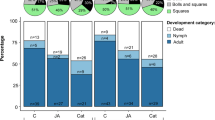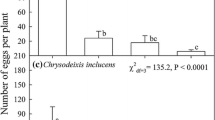Abstract
The present paper reports case study results of the risk assessment of transgenic Bt cotton on a non-target pest, cotton aphid, Aphis gossypii. Several types of techniques, i.e., electrical penetration graph (EPG), light and electron microscopy, bioassays and chemical analysis, were applied to investigate physical and chemical leaf factors of 2 transgenic Bt cotton lines (GK12 and GK19) and their parental non-Bt cotton line (Simian3) associated with searching and feeding behaviors of cotton aphids on leaves or leaf extracts of cotton plants. EPG results showed that there were some differences among behaviors of cotton aphids on 2 Bt cotton and 1 non-Bt cotton lines. Cotton aphids performed similarly to leaf surface extracts from 3 cotton lines; and leaf surface chemicals, mainly volatiles and waxes, were almost identical in the components and concentrations among the cotton lines. However, three cotton lines were quite different from each other in the densities of certain kinds of covering trichomes. Therefore, the relationships between the physical characteristics and the searching behaviors of cotton aphids on the three cotton lines were constructed as the regression equations. Glandular trichomes and covering trichomes with 5 branches influenced the cotton aphids’ searching behaviors effectively; and other trichomes with other branches affected aphids in varying ways. These results demonstrated that leaf surface physical factors of transgenic Bt cotton lines different from their parental non-Bt line could affect the penetration behaviors of non-target cotton aphids. Cotton aphids penetrate and feed more easily on two Bt cotton lines than on the non-Bt cotton line.
Similar content being viewed by others
References
Messeguer J. Gene flow assessment in transgenic plants. Plant Cell, Tissue and Organ Culture, 2003, 73: 201–212
Andow D A, Hilbeck A. Science-based risk assessment for nontarget effects of transgenic crops. Bioscience, 2004, 54: 637–649
Sisterson M S, Biggs R W, Manhardt N M, et al. Effects of transgenic Bt cotton on insecticide use and abundance of two generalist predators. Entomol Exp Appl, 2007, 124: 305–311
Sharma H C, Arora R, Pampapathy G. Influence of transgenic cottons with Bacillus thuringiensis cry1Ac gene on the natural enemies of Helicoverpa armigera. Biocontrol, 2007, 52: 469–489
Torres J B, Ruberson J R, Adang M J. Expression of Bacillus thuringiensis Cry1Ac protein in cotton plants, acquisition by pests and predators: A tritrophic analysis. Agric Forest Entomol, 2006, 8: 191–202
Cattaneo M G, Yafuso C, Schmidt C, et al. Farm-scale evaluation of the impacts of transgenic cotton on biodiversity, pesticide use, and yield. Proc Natl Acad Sci USA, 2006, 103: 7571–7576
Zhang G F, Wan F H, Lovei G L, et al. Transmission of Bt toxin to the predator Propylaea japonica (Coleoptera: Coccinellidae) through its aphid prey feeding on transgenic Bt cotton. Environ Entomol, 2006, 35: 143–150
Naranjo S E. Long-term assessment of the effects of transgenic Bt cotton on the abundance of nontarget arthropod natural enemies. Environ Entomol, 2005, 34: 1193–1210
Rosi-Marshall E J, Tank J L, Royer T V, et al. Toxins in transgenic crop byproducts may affect headwater stream ecosystems. Proc Natl Acad Sci USA, 2007, 104: 16204–16208
Rose R, Dively G P. Effects of insecticide-treated and lepidopteran-active Bt Transgenic sweet corn on the abundance and diversity of arthropods. Environ Entomol, 2007, 36: 1254–1268
Floate K D, Carcamo H A, Blackshaw R E, et al. Response of ground beetle (Coleoptera: Carabidae) field populations to four years of Lepidoptera-Specific Bt corn production. Environ Entomol, 2007, 36: 1269–1274
Gathmann A, Wirooks L, Hothorn L A, et al. Impact of Bt maize pollen (MON810) on lepidopteran larvae living on accompanying weeds. Mol Ecol, 2006, 15: 2677–2685
Li F F, Ye G Y, Wu Q, et al. Arthropod abundance and diversity in Bt and non-Bt rice fields. Environ Entomol, 2007, 36: 646–654
Bai Y Y, Jiang M X, Cheng J A, et al. Effects of CrylAb toxin on Propylea japonica (Thunberg) (Coleoptera: Coccinellidae) through its prey, Nilaparvata lugens St(a)over-circlel (Homoptera: Delphacidae), feeding on Transgenic Bt rice. Environ Entomol, 2006, 35: 1130–1136
Chen M, Ye G Y, Liu Z C, et al. Field assessment of the effects of transgenic rice expressing a fused gene of cry1Ab and cry1Ac from Bacillus thuringiensis Berliner on nontarget planthopper and leafhopper populations. Environ Entomol, 2006, 35: 127–134
Cui J J, Xia J Y. Effects of Bt (Bacillus thuringiensis) transgenic cotton on the dynamics of pest population and their enemies. Acta Phytophylac Sin (in Chinese), 2000, 27: 141–145
Reed G L, Andrew S J, Jennifer R, et al. Transgenic Bt potato and conventional insecticides for Colorado potato beetle management: Comparative efficacy and non-target impacts. Entomol Exp Appl, 2001, 100: 89–100
Deng S D, Xu J, Zhang Q W, et al. Effect of transgenic Bt cotton on population dynamics of the non-target pests and natural enemies of pests. Acta Entomol Sin (in Chinese), 2003, 46(1): 1–5
Wan P, Huang M S, Wu K M, et al. Effects of transgenic Bt cotton on development and population dynamics of cotton aphid. Sci Agric Sin (in Chinese), 2003, 36(12): 1484–1488
Wang W G, Wu K M, Liang G M, et al. Occurrence of cotton pests in the Bt cotton fields and its control strategy. Plant Protection (in Chinese), 1999, 25(1): 3–5
21 Wu K M, Guo YY. Influences of Bacillus thuringiensis Berliner cotton planting on population dynamics of the cotton aphid, Aphis gossypii Glover, in Northern China. Environ Entomol, 2003, 32(2): 312–318
McLean D L, Kinsey M G. A technique for electrical recording aphid feeding and salivation. Nature, 1964, 202: 1358–1359
Tjallingii W F. Electronic recording of penetration behaviour by aphids. Entomol Exp Appl, 1978, 24: 521–530
Tjallingii W F. Electrical recording of stylet penetration activities. In: Minks A K, Harrewijn P, eds. Aphid, Their Biology, Nature Enemies and Control, 1988. 2B,95-108
Ellsbury M M, Backus E A, Ullman D L. History, development, and application of AC electrical insect feeding monitors. Entomological Society of America, Lanham, MD: Thomas Say Publications in Entomology, 1994
Walker G P, Backus E A, eds. Principles and applications of electronic monitoring and other techniques in the study of homopteran feeding behavior. Entomological Society of America, Lanham, MD: Thomas Say Publications in Entomology, 2000
Martin B, Collar J L, Tjallingii W F, et al. Intracellular ingestion and salivation by aphids may cause the acquisition and inoculation of non-persistently transmitted plant viruses. J General Virol, 1997, 78(10): 2701–2705
Johnson D D, Walker G P, Creamer R. Stylet penetration behavior resulting in inoculation of a semipersistently transmitted closterovirus by the whitefly Bemisia argentifolii. Entomol Exp Appl, 2002, 102(2): 115–123
Backus E A, Habibij J, Yan F M, et al. Stylet penetration by adult Homalodisca coagulata on grape: Electrical penetration graph waveform characterization, tissue correlation, and possible implica-tions for transmission of Xylella fastidiosa. Ann Entomol Soc Am, 2005, 98(6): 787–813
Garzo E, Soria C, Gomez-Guillamon M L, et al. Feeding behavior of Aphis gossypii on resistant accessions of different melon genotypes (Cucumis melo). Phytoparasitica, 2002, 30(2): 129–140
Constable G A, Rawson H M. Carbon production and utilization in cotton: Inferences from a carbon budget. Austral J Plant Physiol, 1980, 7: 539–553
Wullschleger S D, Oosterhuis D M. Photosynthesis, transpiration, and water-use effieiency of cotton leaves and fruit. Photosynthetica, 1991, 25: 505–515
Dimock M B, Kennedy G G. The role of glandular trichomes in the resistance of Lycopersicon hirsutum f. glabratum to Heliothis zea. Entomol Exp Appl, 1983, 33: 263–268
Yencho G C, Tingey W M. Glandular trichomes of Solanum berthaultii alter host preference of the Colorado potato beetle, Leptinotarsa decemlineata. Entomol Exp Appl, 1994, 70: 217–225
Eigenbrode S D, Espelie K E. Effects of plant epicuticular lipids on insect herbivores. Ann Rev Entomol, 1995, 40: 171–194
Eigenbrode S D, Castagnola T, Roux M B, et al. Mobility of three generalist predators is greater on cabbage with glossy leaf wax than on cabbage with a wax bloom. Entomol Exp Appl, 1996, 81(3): 335–343
Wilkens R T, Shea G O, Halbreich S, et al. Resource availability and the trichome defenses of tomato plants. Oecologia, 1996, 106(2): 181–191
Chatzivasileiadis E A, Sabelis M W. Toxicity of methyl ketones from tomato trichomes to Tetranychus urticae Koch. Exp Appl Acarol, 1997, 21(6–7): 473–484
Krips O E, Kleijn P W, Willems P E L, et al. Leaf hairs influence searching efficiency and predation rate of the predatory mite Phytoseiulus persimilis (Acari: Phytoseiidae). Exp Appl Acarol, 1999, 23(2): 119–131
De Clercq P, Mohaghegh J, Tirry L. Effect of host plant on the functional response of the predator Podisus nigrispinus (Heteroptera: Pentatomidae). Biol Contr, 2000, 18(1): 65–70
Romeis J, Shanower T G, Zebitz C P W. Physical and chemical plant characteristics inhibiting the searching behaviour of Trichogramma chilonis. Entomol Exp Appl, 1998, 87: 275–284
Tjallingii W F. Continuous recording of stylet penetration activities by aphids. In: Campbell R K, Eikenbary R D, eds. Aphid-Plant Genotype Interactions. Amsterdam: Elsevier, 1990, 89–99
SAS, User manual. SAS company, 1998
Kamel S A, Elkassaby F Y. Relative resistance of cotton varieties to spider mites, leafhoppers, and aphids. J Econom Entomol, 1965, 58: 209–212
Aharoni A, Giri A P, Deuerlein S, et al. Terpenoid metabolism in wild-type and transgenic arabidopsis plants. Plant Cell, 2003, 15: 2866–2884
Yan F M, Bengtsson M, Anderson P, et al. Antennal response of cotton bollworm (Heliocoverpa armigera) to volatiles in transgenic Bt cotton. J Appl Entomol, 2004, 128(5): 354–357
Webber I E. Anatomy of the leaf and stem of Gossypium. J Agric Res, 1938, 57: 269–286
Charles T B, McCarty J C, Jenkins J N, et al. Frequency of pigment glands and capitate and covering trichomes in nascent leaves of selected cottons. Crop Sci, 1983, 23: 369–371
Bondada B R, Oosterhuis D M. Comparative epidermal ultrastructure of cotton (Gossypium hirsutum L.) leaf, bract and capsule wall. Ann Bot, 2000, 86(6): 1143–1152
Ehleringer J. Leaf absorptances of Mojave and Sonoran desert plants. Oecologia, 1981, 49: 366–370
Baldocchi D, Verma S B, Rosenberg N J, et al. Leaf pubescence effects on the mass and energy exchange between soybean canopies and the atmosphere. Agron J, 1983, 75: 537–542
Melcher P J, Goldstein G, Meinzer F C, et al. Determinants of thermal balance in the Hawaiian giant rosette plant Argyroxiphium sandwicense. Oecologia, 1994, 98: 412–418
Brewer C A, Smith W K. Patterns of leaf surface wetness for montane and subalpine plants. Plant, Cell and Environment, 1997, 20: 1–11
Levin D A. The role of trichomes in plant defense. Q Rev Biol, 1973, 48: 3–15
Johnson B. The influence on aphids of the glandular hairs on tomato plants. Plant Pathol, 1956, 5: 130–132
Horn D J. Ecological Approach to Pest Management. London: the Guilford Press, 1988
Khan M M H, Kundu R, Alam M Z. Impact of trichome density on the infestation of Aphis gossypii Glover and incidence of virus disease in ashgourd Benincasa hispida (Thunb.) Cogn. Int J Pest Manage, 2000, 46(3): 201–204
Wang S, Wang J W, Yu N, et al. Control of plant trichome development by a cotton fiber MYB gene. Plant Cell, 2004, 16: 2323–2334
Liu X D, Zhai B P, Zhang X X, et al. Impact of transgenic cotton plants on a non-target pest, Aphis gossypii Glover. Ecol Entomol, 2005, 30: 307–315
Author information
Authors and Affiliations
Corresponding author
Additional information
Supported by the National Key Basic Research Program (Grant No. G2000046803), National Natural Science Foundation of China (Grant No. 39970153) and the Public and Professional Project of Environmental Protection of China (Grant No. 200709047)
Rights and permissions
About this article
Cite this article
Xue, K., Deng, S., Wang, R. et al. Leaf surface factors of transgenic Bt cotton associated with the feeding behaviors of cotton aphids: A case study on non-target effects. Sci. China Ser. C-Life Sci. 51, 145–156 (2008). https://doi.org/10.1007/s11427-008-0028-6
Received:
Accepted:
Issue Date:
DOI: https://doi.org/10.1007/s11427-008-0028-6




